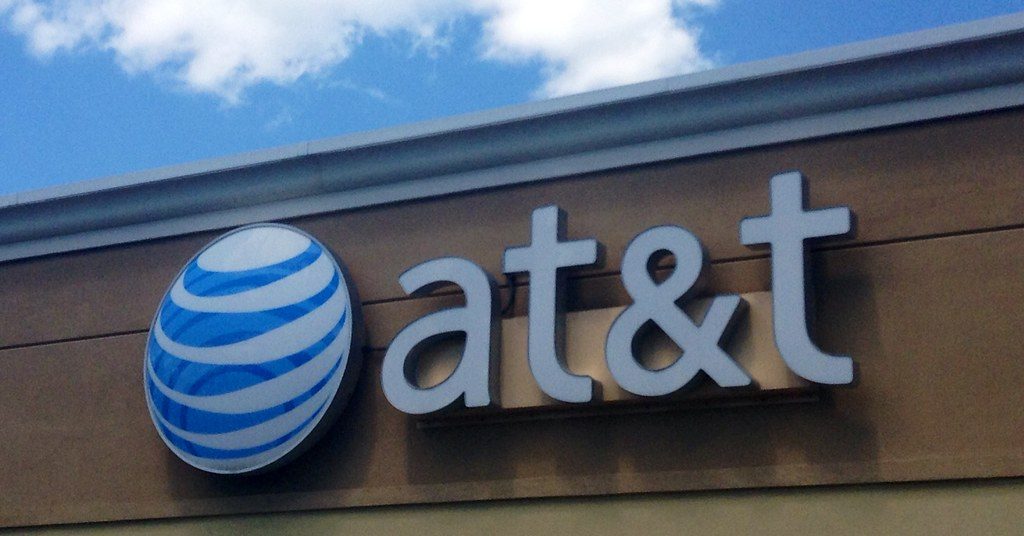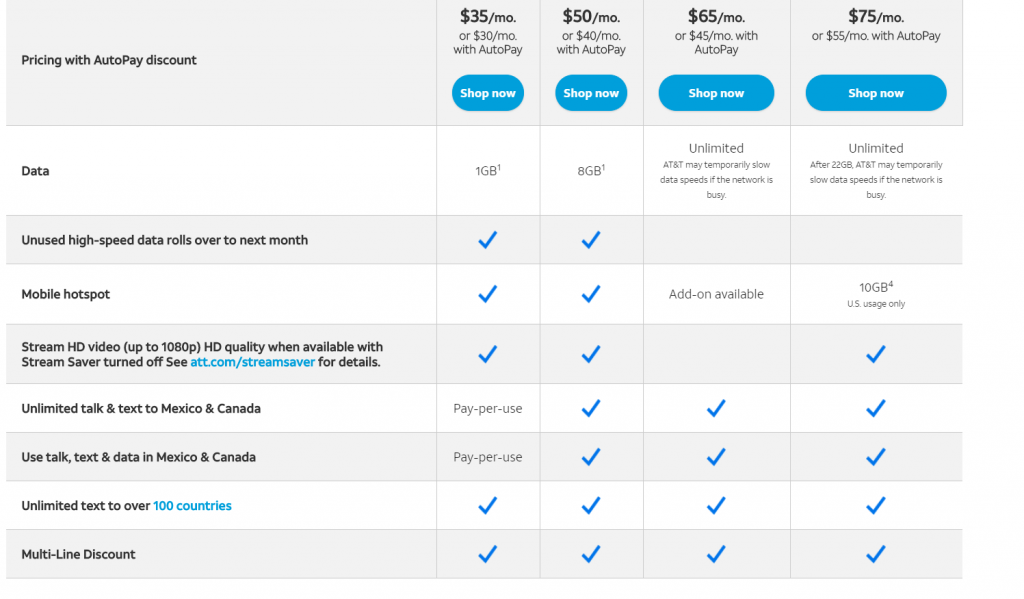The average AT&T bill for a single line is $80 a month. AT&T is often the most expensive carrier, with some people paying hundreds of dollars per month for seemingly little in return. In recent years, this has inspired many people to look to other cellular providers.
Nowadays, there’s a large variety of budget operators who offer much more price flexibility than the big four networks. AT&T actually has its own brand, Cricket. With Cricket, you get the coverage and performance of the AT&T network at a much more affordable price.
Is it worth to switch from AT&T to Cricket? Read the guide below to find out.

TL;DR: Should I Switch or Not?
If you don’t need much in terms of customer service and don’t mind a slight reduction in data speeds, then it’s worth it to switch to Cricket. But power users will likely prefer staying with AT&T for several reasons we get into in this guide. Likewise, if you need to lease a phone, AT&T is a better choice.
About AT&T

AT&T (officially AT&T Mobility) traces its origins to the invention of the telephone in 1877. It is the largest carrier in the US without over 160 million subscribers. AT&T originally stood for American Telephone and Telegraph. Now AT&T is just the same similar to until becoming just the company name in later years.
Both AT&T Mobility and Verizon came from the dismantling of the original AT&T monopoly in 1982. AT&T has long focused on cellular communications and has been a major national player in the industry since the early 2000s when it was formerly known as Cingular.
Today, AT&T primarily caters to contract postpaid customers, but also offers prepaid service under its own name. We’ll take a look at both prepaid and postpaid service.
AT&T Pros
- Strong reliability and coverage
- eSim compatible
- Large selection of plans and phones
- International perks
- Stores can be found everywhere
- TV streaming on unlimited plans
- Perks like HboGo
AT&T Cons
- Plans are more expensive than other carriers
- Low hotspot allotments
- Low data deprioritization limit on unlimited plans
About Cricket

Cricket was formerly the fifth-largest provider in the US. It still has an extensive network across many states, including Arizona, Texas, Pennsylvania, Nevada, and several others. AT&T purchased Cricket in 2013 and now operates it as a prepaid budget option.
Cricket uses AT&T’s networks, so it generally has excellent service across the country. However, Cricket has an imposed speed cap of 8 Mbps on most of its plans (3Mpbs on Cricket Core), so it may not be the best option for serious streamers.
Overall, Cricket’s strength is the variety of plans its offers in the $25-60 per month per Line range before discounts. It is one of the best options among all carriers for people looking for discounts on family/multi-line plans.
Cricket Pros
- Uses AT&T National Coverage
- Bring your own phone and a large number of compatible options
- Significant savings on family plans
- Unlimited international texting to 38 countries with higher-tier plans
- No online activation fee
- Good selection of budget smartphones
- Decent amount of stores and retail partners
Cricket Cons
- Unlimited LTE is more expensive than other budget competitors
- Have to select the highest plan for mobile hotspot
- No free music streaming feature
- Poor customer service
AT&T Plans

AT&T has both prepaid and postpaid plans. Like the other major carriers, they also have a ton of different plans and options for you to customize data, voice, and text. We’re going to focus on prepaid plans vs. Cricket to help you make sense of the better choice for you.
AT&T’s prepaid plans are pretty expensive compared to Cricket:
- 1 GB: $35 per month ($30 with Auto-pay)
- 8 GB: $50 per month ($40 with Auto-pay)
- Unlimited: $65 ($50 with Auto-pay)
- Unlimited + 10 GB Mobile Hotspot: $75 ($70 with Auto-pay)
For reference, these are the prices of AT&T monthly postpaid plans:
- Unlimited Starter – $65/Single Line
- Unlimited Extra – $75/Single Line
- Unlimited Elite – $85/Single Line
Note that the mobile hotspot isn’t available until the Unlimited Extra plan, which provides 15GB of hotspot data (30 GB for Elite).
Cricket Plans

Cricket has a variety of prepaid, no-contract plans. They do not offer any postpaid plans. We’ll focus on the main ones they offer:
- 2GB: $30
- 5GB: $40
- Unlimited BYOD: $40 (limited time only)
- Cricket Score (Unlimited): $55
- Cricket More (Unlimited + 15GB mobile hotspot): $60
*The Cricket Core Plan offers data speeds at a max of 3Mbps while Cricket More provides unlimited data access on 4G LTE speeds (although the network may slow due to congestion, regardless of data usage). Only the Cricket More plan offers a personal hotspot for users.
As you can see, all of the Cricket prepaid plans are cheaper per month than AT&T. Most users will hardly notice a difference with the speed caps as well. However, if you’re really looking for value, you can find better deals at the other carriers.
T-Mobile offers 10 GB of data for $40 and unlimited for $50, and you don’t have to worry about deprioritization. Straight Talk is another good example. They offer 25 GB of data for $45 per month. And with Straight Talk, you can still have the advantage of using the AT&T network.
Winner: Cricket
Cricket vs. AT&T: Family Plans

Family plans are really where Cricket shines. For two or more lines, you can unlock some serious savings with the budget carrier. They are priced between $80-$125 and are a part of the Cricket Core Plan with:
- Unlimited calls and messages
- Unlimited data at 3 Mbps speeds
- Unlimited Video Streaming at 480P
Cricket also has fixed-rate data plans from $70-$130 per month at 5 GB per Line at 8 Mbps speeds.
AT&T’s family plans are a better deal than single lines. But they don’t unlock that much in terms of savings. When it comes to multi-line plans, Cricket is the clear winner not just with AT&T but is a top choice.
The only other carriers offering this combination of value and features are Metro by T-Mobile and Total Wireless. If you want to stay with a big four carrier, Sprint’s $100 Unlimited Plus Family Plan undercuts most competitors putting their prices on par with budget carriers like MetroPCS and Cricket.
Winner: Cricket
Cricket vs. AT&T: Coverage and Performance

Cricket uses the AT&T network so you can expect similar coverage and reliability between the two. In national rankings, AT&T generally ranks second or third behind Verizon while alternating spot with T-Mobile.

The main difference, however, is the speed caps and deprioritization that AT&T imposes on Cricket customers. This means during times of network congestion, or if you’ve used excessive amounts of data (over 30 GB on an unlimited plan), you may be throttled until the next billing cycle.
While this may sound concerning, the vast majority of average users don’t notice a difference. If you don’t need to run your entire life from your phone, then it shouldn’t be a problem for you. This is especially true if you can save $20-30 a month on your phone bill.
Winner: Tie
Cricket vs. AT&T: BYOD
Both Cricket and AT&T allow you to bring your own device to the network. A SIM kit from AT&T usually costs $4.99, while Cricket charges between $4.99-$9.99 depending on the retailer.
Cricket routinely and is currently offering an unlimited BYOD plan for $40. If this offer is still available, you really can’t beat it.
AT&T does offer eSim compatibility. But you still need a physical eSIM activation card, which somewhat defeats the purpose. Still, if you have a newer model unlocked phone, it’s a great option. But don’t expect any discounts on prepaid plans.
Winner: Cricket
Cricket vs. AT&T: Buying and Leasing Phones
You can purchase the latest flagships and budget smartphones from both carriers. Cricket has a large inventory of many phones under $300 that you can choose from.
You can also lease-to-own phones from both carriers. However, Cricket’s “Progressive Leasing” system can get expensive with interest payments. You might not pay anything upfront, but it’s going to hurt you over time.

This is one area where AT&T really outshines Cricket. With AT&T, you can lease phones for no additional fees. Plus, AT&T routinely has incentives like free or discounted iPhones for new lines. The catch is you’ll have to qualify and sign up for a postpaid contract, but it’s still a much better overall value than paying too much in interest.
Most budget carriers are similarly designed with high interest on phone leases. Stick to buying the phone outright or finding different ways to pay it off monthly. Some banks and credit card companies will actually let you space out payments for a minimal amount of fees.
Winner: AT&T
Cricket vs. AT&T: Customer Service
If you’ve suffered through AT&T customer service and wonder if it can get any worse, it can. One of the main places you’ll feel the price difference with any budget carrier is customer service.
AT&T generally ranks third (ahead of Sprint) among carriers in terms of customer service. Cricket ranks higher than most of its peers like Straight Talk or TracFone. But you should expect to solve most of your issues yourself or through users forums. Cricket does have live chat, which is helpful, though.
AT&T now has a priority service option, but you have to be a qualifying elite customer to access it.
Here are the toll-free numbers for both services:
- Cricket Wireless: 1-800-274-2538
- AT&T: 1-800-331-0500
Winner: AT&T
Cricket vs. AT&T: Perks & Rewards
AT&T’s rewards program is AT&T Thanks. You get 1-4 of these options depending on your rate plan:
AT&T Perks and AT&T Thanks:
- Premium channels. If you upgrade to the AT&T Elite plan, you can choose between HBO, Cinemax, Starz, or Showtime for free. Or you can select Amazon Music, Pandora Premium, or Spotify.
- Priority customer service
- Sports and dining discounts
Cricket Rewards
Cricket have rewards programs. Most of these are discounts for using features like auto-pay, paying bills on time, signing up friends, etc. Don’t expect free movie tickets, but it is an excellent way to save a little more on your monthly phone bill.
Winner: AT&T
Cricket vs. AT&T: Final Thoughts
Cricket offers some modest discounts on individual lines and some serious savings on family plans compared to AT&T. If you just need one line, Cricket isn’t a bad option, particularly with the current $40 unlimited BYOD plan. But you can find a better value with T-Mobile or Straight Talk, and you don’t have speed caps.
When it comes to family plans, however, few prepaid plans compete with Cricket. It’s no contract, so you can easily add or remove lines each month, and you can get four lines of unlimited data for $100 compared to $140 with AT&T. Start saving and make the switch now.
Head over to the Buyback Boss Blog to check out more cellular carrier comparisons, learn about different smartphones, and a whole lot more. T-Mobile and MetroPCS both offer great deals, see which is better here. Or make the most out of your data plan with these fantastic iPhone games. Discover everything you want to know about smartphones, cellular carriers, and more on our blog now!






